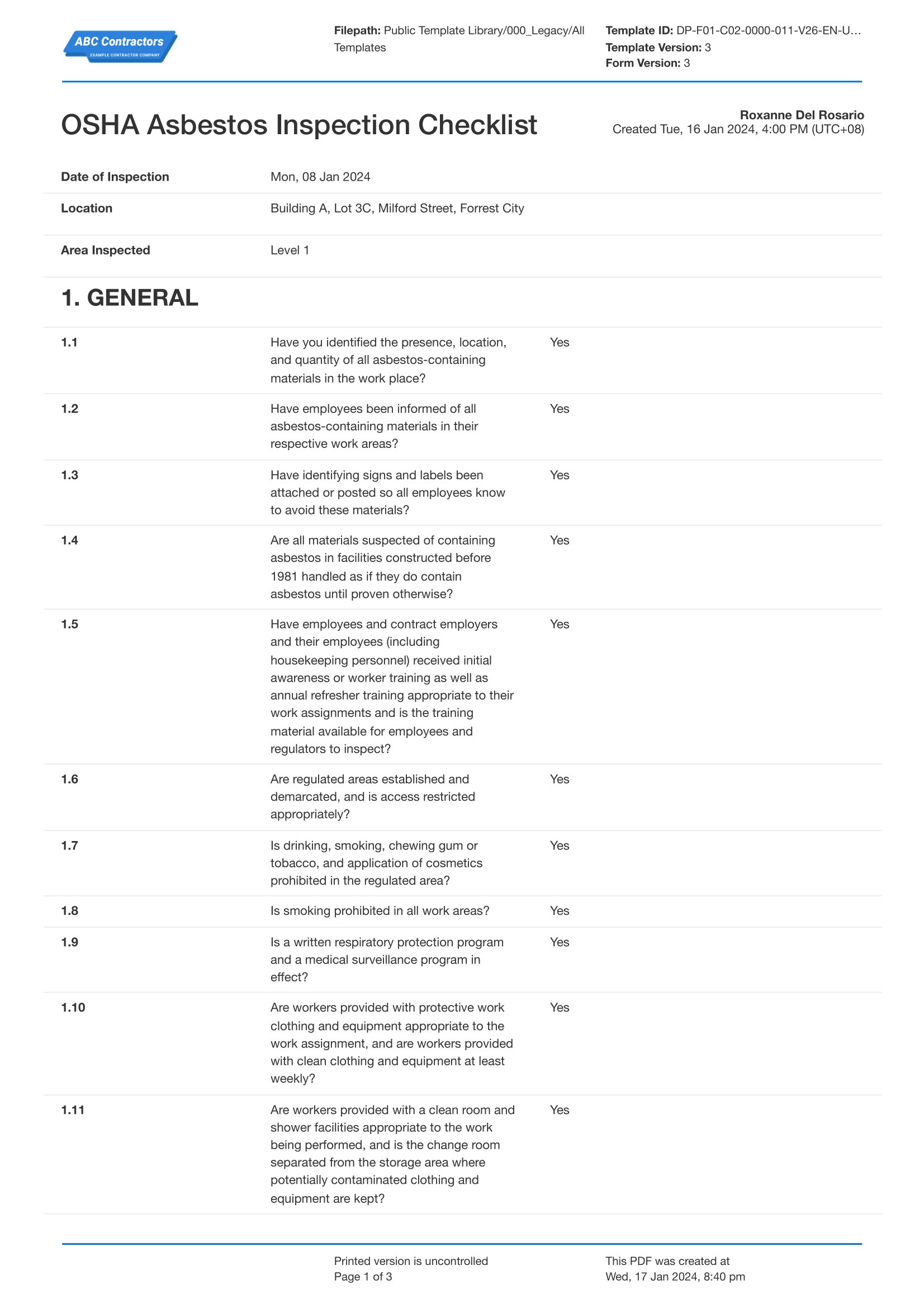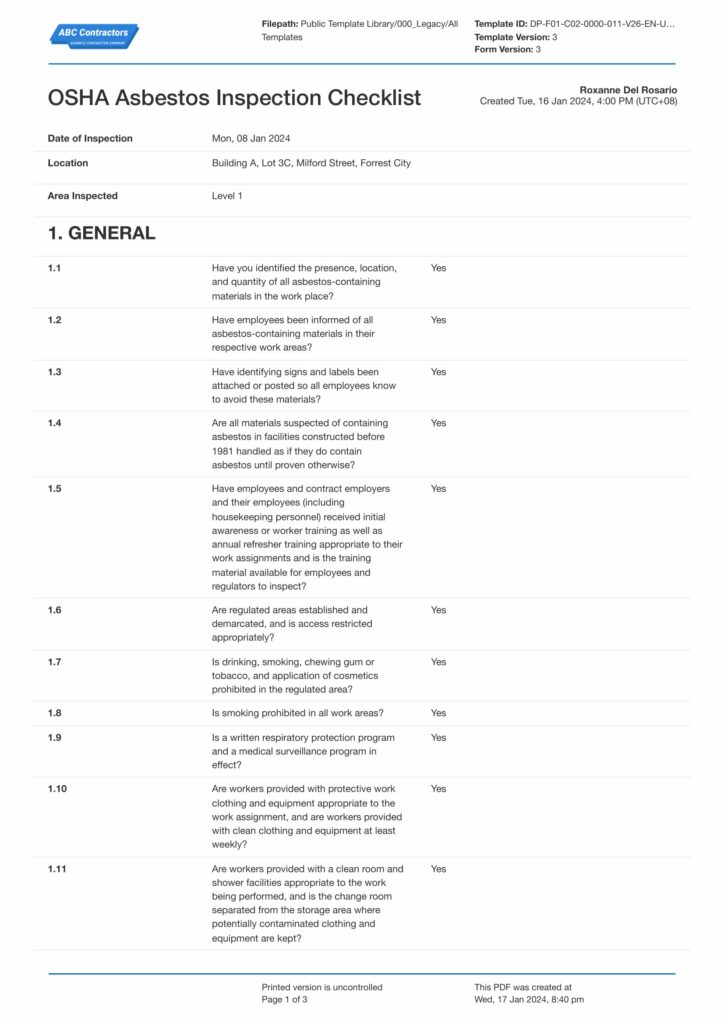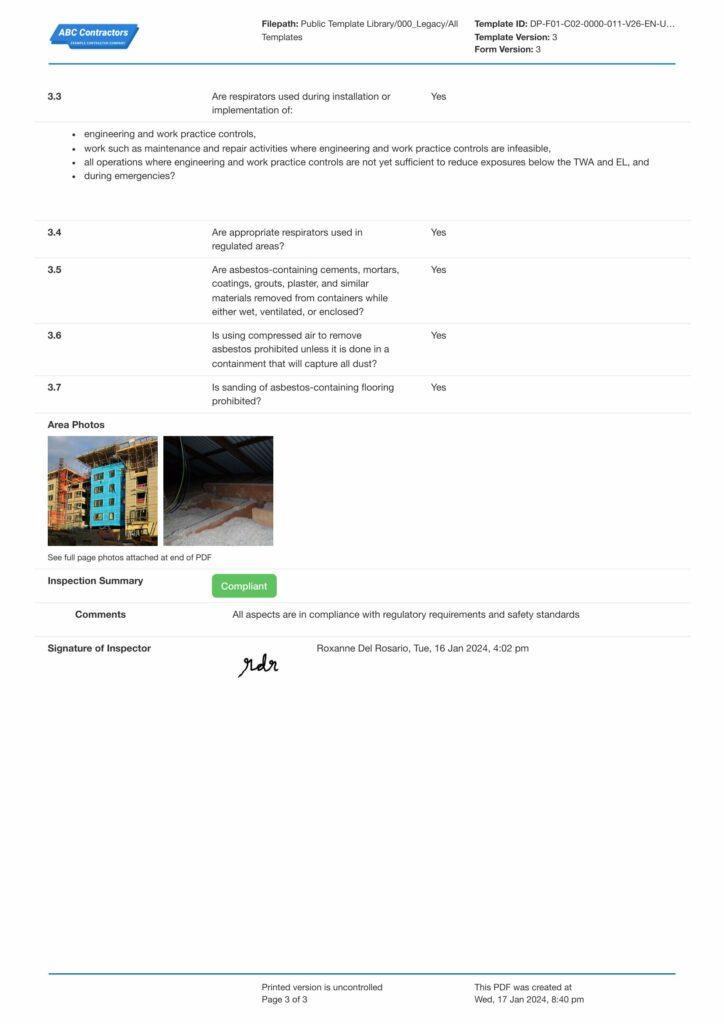Dashpivot Article – OSHA Asbestos in Construction

OSHA Asbestos in Construction
Asbestos is a general term for a group of naturally occurring, fibrous materials with high tensile strength and high flexibility, which can also resist heat, chemicals, and even electricity. However, these good properties have bad effects, which can cause serious health hazards, especially in the construction industry. OSHA asbestos in construction relates to OSHAs influence and impact over ensuring that construction workers are protected from these serious health hazards in the best ways possible.
If/when these asbestos fibres are inhaled, they can lead to severe diseases such as mesothelioma, asbestosis, and even lung cancer. Given these inherent risks, the Occupational Safety and Health Administration has set specific regulations to handle asbestos correctly on construction sites.
In this article, let’s dive deeper into OSHA asbestos regulations in construction, their health implications, and some best practices for a safer construction project.
Background on Asbestos in Construction and the Dangers They Pose
In construction settings, asbestos can be found in several products such as sprayed-on fireproofing, pipe insulation, ceiling & floor tiles, roofing felts, shingles, and even acoustic products. However, only a few asbestos-containing products are being used today, and most worker exposures occur during the removal, renovation, and maintenance of buildings and structures.
Asbestos fibres can cause severe diseases
These tiny, asbestos fibres can enter the body when a person inhales or ingests these airborne particles that become embedded in the respiratory tract or the digestive system. Frequent exposure to asbestos can cause disabling or even fatal diseases such as asbestosis, a long-term condition that causes shortness of breath and lung cancer, and mesothelioma, a cancerous tumour that can spread rapidly in cells of membranes covering the lungs and body organs. Digestive diseases like gastrointestinal cancer can also be caused by frequent exposure to asbestos fibres. These symptoms do not appear for 20 years or more after initial exposure, so it is crucial that asbestos-containing materials must be handled accordingly.
OSHA's Role in Regulating Asbestos in Construction
The Occupational Safety and Health Organisation (OSHA) plays a very important role in protecting workers from asbestos exposure in the construction industry. 29 CFR Part 1926.1101 is the OSHA standard for asbestos rules and regulations.
OSHA Asbestos Classification for Construction Work
The Occupational Safety and Health Organisation has broken down construction work into job classification systems according to how asbestos is handled on-site. The following are the classifications of construction work relating to asbestos:
Class I jobs are the most hazardous construction work, as this includes the removal of asbestos-containing material used in thermal insulation, which is sprayed-on or troweled-on surfacing materials.
Class II jobs include the removal of other asbestos-containing materials that are not thermally insulated, for example, resilient flooring and roofing materials. Other examples of Class II work include asbestos-containing floor or ceiling tile removal, siding, roofing, or transit panels for residential and commercial uses.
Class III construction work jobs include asbestos-containing materials that have been disturbed or are considered to be under repair and maintenance work.
Class IV work is where employees clean up asbestos-containing waste or material that has been generated from construction, repair or maintenance activities, including cleaning surfaces by vacuuming or mopping that is covered with dust from thermal system insulation or surfacing material.
Key Provisions of OSHA’s Asbestos Regulations in Construction
Employers in an asbestos workplace must do exposure assessments, and if the asbestos levels exceed the PEL, then engineering controls (ventilation systems) and work practice controls (to reduce airborne asbestos fibres) must be provided, and workers must be able to wear PPE.
Medical Surveillance and Training
For employees working with asbestos at levels right or exceeding the limits, medical surveillance must be conducted at all times. Regularly monitoring the medical status and conducting examinations such as lung-function tests are key measures organisations should impose. Aside from these, the employer must also conduct training on the dangers behind asbestos mishandling and, most importantly, proper methods of asbestos control measures.
Asbestos Regular Recordkeeping
An OSHA asbestos inspection checklist will keep track of what’s been inspected and signed off on, as it will keep the measurements and medical surveillance requirements. Employers and organisations are to track and keep data for at least 30 years since the symptoms may not show until then.
Asbestos Exposure Limits and Global Considerations
OSHA has been the leader in regulating asbestos, but different countries have different standards followed or set on construction sites. Some countries are completely banning its use, while others are still hesitant and are still using asbestos-containing materials in their construction sites. Organisations, especially in these countries, must take note, and there must be constant reviews and updates so their workers are protected at all times. Frequent inspections and audits ensure the risks are identified before they happen, most especially if the workers are exposed to asbestos on a regular basis.
Read more about OSHA Asbestos Exposure Limits.
Construction Site Asbestos Challenges and How they Can be Countered Using Technology
Asbestos-related diseases such as those mentioned above have a latency period of 20-50 years, and that’s a long time to prove cause and effect, so organisations need to act as early as now. Here are some best practices for construction sites to follow or benchmark for handling asbestos-containing materials:
OSHA Asbestos in Construction Training and Risk Management
With the frequent use of virtual reality and artificial intelligence these days, simulations and interactive learning platforms can help train workers on asbestos exposure risks. These can also include cloud-based risk assessments that can preserve and analyse data to predict exposure to happen, which can greatly reduce health risks associated with asbestos.
Detection Systems
Prevention is always better than cure, so it is always better to employ detection equipment in construction sites before these health risks associated with asbestos exposure can happen. Tech like phase contrast microscopy with digital imaging and portable X-ray fluorescence analysers can fast-track asbestos material identification and even keep digital records for OSHA compliance.
Automated Response Technology
Modern construction sites have automated emergency response systems that can help trigger actions when asbestos fibre levels rise above the limits. These high-tech, automated response systems employed in these sites can help control ventilation and containment and provide alerts to people through mobile apps. As a bonus, real-time data can also be shared with stakeholders to easily respond to exposure accidents.
Digital Monitoring Solutions
Some construction sites are using digital solutions for asbestos management because these modern software platforms provide real-time air quality monitoring, automated alerts, and documentation systems. They can also help integrate with project management software to comply with Work Health and Safety limits of below 0.1 fibres per millilitre of air.
The OSHA asbestos checklist shown below can be used to monitor OSHA asbestos exposure limits in construction sites with ease.

Keep OSHA asbestos in construction safe using OSHA compliant documentation
Run OSHA asbestos inspections with ease
Use this digital OSHA asbestos inspection checklist template to meet your OSHA asbestos needs and keep your team safer from asbestos. All the fields and sections you need to run detailed, thorough inspections are pre-built, including checklist items you can customise to your specific project. You can also share your completed asbestos inspections as perfectly formatted CSV or PDF.
Manage your OSHA asbestos inspections electronically
Using a digital OSHA asbestos inspection can make it easy to record the inspection, but a dedicated OSHA Asbestos Inspection app makes it easy to keep track of what work has been done and when. You can also see a chronological view of inspections completed in the Timeline view, or if you need more detail, toggle to the Register view in a single click to see a spreadsheet view of data in the reports. Your team can see all the information relevant to them by breaking up documents into folders by team or project so they don't get lost in a mountain of paperwork.
Final Thoughts
Asbestos in construction remains one of the challenges that need close monitoring in respect of safety practices and regulatory compliance. Though the regulations under OSHA are elaborate enough to guarantee worker safety, implementation requires a methodical approach in modern terms. As the latency period of diseases related to asbestos is relatively long, there is a constant need for maintaining detailed records in construction companies while applying preventive measures right from day one.
Utilise Tech for Better Asbestos Handling
With the advent of digital technology, construction companies can enhance their asbestos management programmes immensely by using tech-driven solutions.
Software like Dashpivot provides a holistic solution to OSHA compliance management in conducting and documenting inspections and keeping long-term records. These solutions not only facilitate documentation but also enable real-time monitoring, thereby keeping exposure levels within safe limits and protecting workers for their entire careers.
By combining strict guidelines from OSHA with modern digital tools, the construction company creates a safer environment, maintains compliance records better, and protects what is most precious—its people. Switch to digital asbestos management today and start taking control of your site's safety and compliance requirements.

OSHA Pre-Task Plan template
Ensure your OSHA Pre-Task Plans are compliant by using this free digital template.

OSHA form 300 & 300a template
Maintain your log of injuries and illnesses and your 300a summary with this free template.

OSHA Incident Report form 301 template
Properly document your injury and illnesses on site with this OSHA Injury and Illness Incident Report form 301 template.


